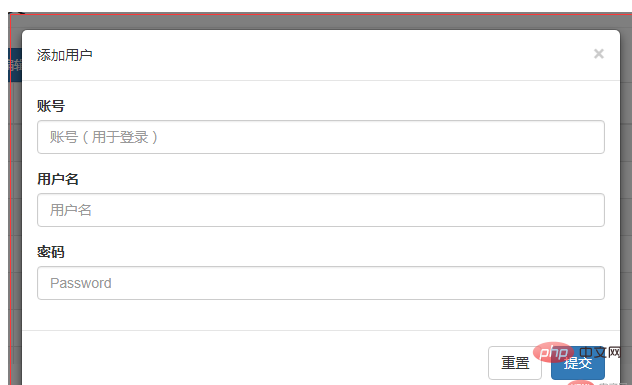Home >Web Front-end >Bootstrap Tutorial >What is the usage of bootstrap remote?
Usage of bootstrap remote: First set up the main page and place a modal box; then put a button on the main page to trigger the display of the modal window; then bind a click event to the button; Finally, use "remote: '/sys/toAddUser'" to load the content address remotely.

The operating environment of this tutorial: Windows 7 system, bootsrap version 3.3.7. This method is suitable for all brands of computers.
Recommended: "bootstrap video tutorial" "css video tutorial"
Bootstrap's Modal modal window component is still very useful. But during the development process, most of the content in the modal window is loaded from the backend. To realize that the content of the modal window is loaded from the backend, there are two commonly used implementation methods. They are:
(1) There is an Iframe in Modal, and the remote content is loaded through the src of the Iframe. The disadvantage of this method is that the width and height of the modal box are difficult to adjust, and setting the width and height to fixed values destroys the responsive layout of bootstrap.
(2) Use Modal's remote parameter to load remote content. There are some minor bugs in this method (the solution will be introduced later), but this method does not have the trouble of manually setting the width and height of the previous method.
Personally, I prefer the second method, so I will introduce the method of using remote.
Note: The version of bootsrap used this time is 3.3.7
1. Page preparation
(1) Main page
Main page here , first place a modal box, but the content in the modal box is blank. The data after subsequent remote loading will be automatically filled into the Div class="modal-content". Prepare the following html code:
<!-- 弹出模态窗口-->
<div class="modal fade" style="top:13%;" tabindex="-1" role="dialog" id="showModal">
<div class="modal-dialog" role="document">
<div class="modal-content">
<!-- 内容会加载到这里 -->
</div>
</div><!-- /.modal-content -->
</div><!-- /.modal-dialog -->
</div><!-- /.modal -->After placing the modal window, we can put a button on the main page to trigger the display of the modal window. The html code of this button is as follows:
<button type="button" id="addBtn" class="btn btn-primary">新增用户</button>
After the button and modal window are ready, we need to bind a click event to this button. After clicking, the modal window will be displayed and data will be loaded remotely. The js code is as follows:
$("#addBtn").click(function(){
// 打开模态框
$("#showModal").modal({
backdrop: 'static', // 点击空白不关闭
keyboard: false, // 按键盘esc也不会关闭
remote: '/sys/toAddUser' // 从远程加载内容的地址
});
});This is the content of the main page. Note: I have not posted the code related to introducing bootstrap at the beginning. You need to introduce it yourself when using it.
(2) Preparation of the page to be loaded into the modal box
First of all, let me say that there is no need to introduce any js and css in this page. Because after this page is loaded into the modal box, it is equivalent to a part of the main page. It feels a bit like the main page dynamically importing it. It can access any content on the main page. This page can be regarded as the DIV content of class="modal-content". After loading, these html codes are embedded into it. Therefore, when writing this page, we can go to the bootstrap official website and copy the code of a modal box, and extract the content inside, which is most suitable for our remote page. The code I prepared is as follows:
<div class="modal-header">
<button type="button" class="close" data-dismiss="modal" aria-label="Close"><span aria-hidden="true">×</span></button>
<h class="modal-title">添加用户</h>
</div>
<div class="modal-body">
<form id="addForm">
<div class="form-group">
<label for="account">账号</label>
<input type="text" class="form-control" id="account" name="account" placeholder="账号(用于登录)">
</div>
<div class="form-group">
<label for="username">用户名</label>
<input type="text" class="form-control" id="username" name="username" placeholder="用户名">
</div>
<div class="form-group">
<label for="password">密码</label>
<input type="password" class="form-control" id="password" name="password" placeholder="Password">
</div>
</form>
</div>
<div class="modal-footer">
<button type="button" id="resetBtn" class="btn btn-default" >重置</button>
<button type="button" id="saveBtn" class="btn btn-primary">提交</button>
</div>2. Introduction to the background
In fact, there is no introduction to the background code. When the button on the main page is clicked, the background receives the request and puts the prepared page It's ok to go back to the past. Use SpringMvc to implement it in one go. So I won’t introduce it.
3. Final effect
By clicking the new button on the main page, the modal box pops up and the remote page is loaded into the remote modal box.

4. Solve the minor bugs
(1) After testing, it was found that the content of this modal window was reloaded in the background once, and then the modal was closed. When the status window is opened again, it will no longer be loaded from the background.
(2) The content in this modal box will remain on the main page after loading, and the main page can be accessed directly. This is prone to problems, for example: there is a DOM element on the homepage with the same ID as the DOM element in the modal box, which is prone to bugs. We hope that the content in the modal window will be cleared directly after the modal window is closed. Lose.
The solution to the above two bugs is shown in the js code below, which actually monitors the closing of the modal window
// 每次隐藏时,清除数据,确保不会和主页dom元素冲突。确保点击时,重新加载。
$("#showModal").on("hidden.bs.modal", function() {
// 这个#showModal是模态框的id
$(this).removeData("bs.modal");
$(this).find(".modal-content").children().remove();
});5. Let’s talk about the precautions
Be careful The thing is that the page loaded remotely is actually a small piece of HTML code, which does not require the introduction of js and css (such as bootstrap's js and css). This is completely different from using Iframe. The content in Iframe can be regarded as a separate page, so you need to introduce js and css yourself when using Iframe.
The above is the detailed content of What is the usage of bootstrap remote?. For more information, please follow other related articles on the PHP Chinese website!